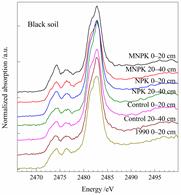| Sulphur Speciation and Transformation in Soil |
| From: PublishDate:2017-06-16 Hits: |
Sulphur (S), an essential plant nutrient, exists in soil in both organic and inorganic forms with different oxidation states, ranging from -2 to +6. The speciation and availability of S could be markedly affected by environmental redox potential and pretreatment condition. Synchrotron-based S K-edge X-ray absorption near edge structure (XANES) spectroscopy, as an in situ technique, can circumvent the limitations such as alterations of oxidation states that degradative wet-chemical extraction techniques usually suffered from, and directly identify and quantify the oxidation states and moieties of S in a variety of environmental and geochemical samples, even under field-moist conditions. To date, molecular-level understanding of the link between various forms of S and their changes in soil is lacking. A research group from Research Center for Eco-Environmental Sciences, Chinese Academy of Sciences provides solid evidence for the effect of fertilizer application on the sulphur speciation and transformation in soil using a combination of wet chemical fractionation and S K-edge XANES spectroscopy. Their research has been published on May 21, 2016 in European Journal of Soil Science, respectively.
Figure 1. Sulphur K-edge XANES spectra (average of three scans) of soil samples from the long-term experiments: control, unfertilized; 1990, reference samples collected in 1990. NPK, inorganic nitrogen, phosphorus and potassium fertilizers; MNPK, NPK plus organic manures.
Sulphur speciation and transformation in soil are investigated with a combination of a wet-chemical fractionation scheme and S K-edge XANES spectroscopy. The results show that organic S accounted for up to 77% of total S in all soil samples. Results from the fractionation (inorganic S plus ester-S) and XANES analysis (oxidized S) are correlated (r =0.585, P<0.01), which confirm the presence of HCl-extractable sulphate and the speciation of residual S in soil. The XANES analysis also confirms the hydrolysis of organic S into inorganic sulphate during the wet-chemical analysis, which overestimates the inorganic sulphate fractions in the soils. The overestimation is particularly clear in the organic carbon-rich soil. This research also provides evidence of the contribution of atmospheric deposition to the S cycle in the soils. The S K-edge XANES spectral data were collected at Beijing Synchrotron Radiation Facility using the Beamline 4B7A equipped with a Si(111) monochromator. The pulverized soil samples were thinly mounted in 2.5-mm Mylar film envelopes and placed into a He purged sample chamber. Distinct differences in S speciation among the following fertilization treatments including no fertilizers (control), regular applications of nitrogen, phosphorus and potassium fertilizers (NPK), or of NPK plus organic manures (MNPK) since 1990 was examined based on the XANES analysis. They suggest that the long-term application of organic manures facilitate significantly the accumulation of intermediate and reduced S species and increase total and organic S in the soils. In addition, the results indicate that the chemical extraction can overestimate the inorganic sulphate fractions in soils since parts of organic S are hydrolyzed into inorganic sulphate during the wet-chemical analysis. The results are great helpful to understanding the speciation and geochemical cycle of sulphur in Chinese arable soils at the molecular scale.
Article: C. Xu, S. Wang, Z. Chen, J. Lv, L. Luo,* J. Li, Y. Ma. Sulphur speciation and availability in long-term fertilized soil: evidence from chemical fractionation and S K-edge XANES spectroscopy. European Journal of Soil Science, 67(2016), 666–675.
|
|
|
| Chinese
- Metal-free efficient photocatalyst for stable visible water splitting——Top ten major scientific progresses in China in 2015
- The nano-resolution imaging platform was awarded the first rate prize of Beijing Science and Technology in 2014
- Beamline 1W1 of BSRF started to runoperate in the couplingparasitic mode of BEPCII
- Synthesis of High Performance Polymer Materials for Field Effect-Transistors
- Surfactant molecular aggregates in green solvents
- GIXRD has played an important role in the characterization of organic thin-film transistors
Science Highlights
Home /
Copyright © 2011 - 2012 Beijing Synchrotron Radiation Facility




